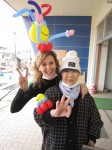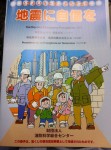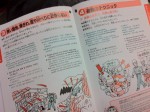Do you know “rakugo”? It’s a kind of s Japanese verbal entertainments.The lone storyteller (“rakugoka“) sits on the stage. Using only a paper fan (“sensu“) and a small cloth (“tenugui“) as props, and without standing up from the sitting position, the rakugo artist depicts a long and complicated comical story.
Most of them are Japanese and perform in Japanese. But recently “eigo rakugo” or English rakugo has been performed in English and it’s become popular both in Japan and overseas. Today we talked to one of English rakugo performers over the phone.
Diane on YouTube! Click →http://www.youtube.com/watch?v=zCOetjUZvFk
Diane Orrett, A.K.A. Daian Kichijitsu, an Osaka-based rakugo performer. Her stage name originates from a Japanese word “taian kichijitsu (大安吉日)”, which means “Lucky Day”. We began the broadcasting with her original short story (Kobanashi), “The art gallery”.
A; Oh, what a lovely gallery, such a wonderful painting. Oh, this one… this is beautiful! This is a… Excuse me, sir! Sorry to disturb you, but is this a da Vinci?
B; This one? No madam. That’s a Rembrant.
A; Rembrant! Oh yeah, of course it is. I knew that. And this one… this is a Rembrant too, right?
B; No madam. That is a Monet.
A; Monet! Of course it’s a Monet, typical Monet style. I knew that. And… Oh dear, oh my goodness! Wow, this one is quite shocking, it’s really rather grotesque! No, no, don’t tell me, I know. This is a Picasso.
B; No madam. Actually that’s a mirror.
Such a really humorous woman went to Tohoku to entertain earthquake victims… But she visited there not as a rakugo performer. She has another face, too – a balloon artist.
Why did she go to the devastated areas? What did she look at and what did she feel? Please listen to the podcast below.
*Interview with Diane Orrett: http://www.myeyestokyo.com/aboutus/interview/pg50.html
<Information>
1. Tokyo Cruise. For more datails, check http://www.suijobus.co.jp/ (J/E/Chi)
2. A booklet for disaster prevention issued by Institute For Fire Safety & Disaster Preparedness called “Jishin ni Jishin wo”. It’s written in J/E/Kor/Chi/Port. In case of Chuo-ku, it’s available at the disaster prevention division counter and the alien registration counter in Chuo-ku City Office.



2 thoughts on “A happy woman visited shelters.”